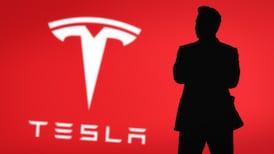Reviewing technology for a living seems like a great job. Being honest, it usually is. An endless parade of shiny toys crossing your desk each month – who wouldn’t love that?
But there have also been a lot of duds over the years. The “rugged” smartphone that smashed in a fall of less than three feet. The watch that claimed to monitor blood sugar but didn’t seem to do it very well. Cheap headphones that were destined for the e-waste heap a minute after breaking them out of the box.
But that doesn’t mean I haven’t been caught out by a few bad personal tech choices. To quote Frank: Regrets, I’ve had a few.
Some of my biggest tech regrets have been products that turned out to be surplus to requirements – a wireless charging mat and adaptors for iPhones, just before Apple decided to integrate the technology itself – or useless duds, such as my experiment with sonic cleaners.
READ MORE
My biggest tech regrets over the years, in no particular order:
The connected kettlebell
Pandemic boredom had a lot to answer for. The Zoom quizzes and drinks parties that became our social lives. The endless banana-bread baking, which led to subscriptions to health-and-fitness platforms so you could do Pilates on a paper-thin mat in your livingroom while your toddler “helpfully” tried to hang off your back.
With everything shut down, the middle aisle at Lidl became a strangely attractive place to splurge the money you weren’t spending on anything else – until the Government shut that down too, at which point online shopping surged.
With that came some very unwise purchases. In my case, it was a connected smart kettlebell. One that justified the price tag because I would definitely, 100 per cent use it to get fit before the world opened up again.
I had visions of emerging from lockdown an altogether healthier person, rather than a stressed-out shell of my former self, sporting a wardrobe that consisted mainly of Sweaty Betty leggings.
I spent far more than I’d like to admit on a JaxJox Kettlebell Connect, a kettlebell that you could electrically adjust so it acted as six kettlebells in one device. I thought it might save space and push me to work with heavier weights.
I was wrong on both counts.
The device was larger than the three kettlebells I already owned stacked together. That made it awkward to use, so it quickly started to gather dust. That was probably a good thing, as its innards started to develop some worrying cracks. The weights were all wrong for me too, another strike against it.
The company has since gone out of business, the app no longer works and the kettlebell’s battery died some time over the past couple of years, and no longer charges. I couldn’t tell you when exactly because I can’t remember the last time I used it.
I’m not sure if it belongs in e-waste, or if I should keep it as a reminder not to impulse buy something just because it has some shiny tech inside. Particularly connected fitness devices.
The video sunglasses

Aka the one that could have caused a divorce. In 2016, Snapchat launched the first generation of its video-enabled sunglasses, Spectacles. They were, predictably, in short supply as everyone tried desperately to get their hands on a pair. To heat demand even further, Snap was limiting the sale initially to pop-up vending machines in US cities, with a strict limit of two pairs per card.
The end result was queues. Long ones. And a thriving resale market that saw the glasses change hands for significantly more than their $130 (€112) selling price.
It just so happened that on one of those limited release dates, I was in New York on holiday. And being a magpie about technology, I was intrigued enough to queue to find out what the fuss was about.
[ Review: Are Snap’s Spectacles worth the hype?Opens in new window ]
I’m not sure what was worse – the fact that I queued so long for something completely unnecessary, that my husband felt obliged to tag along because I was several months pregnant, or the fact that, after six months and $130, I never used them again.
Why? Because unlike the (much later released) Meta Raybans, which could pass for regular sunglasses, they stood out as a Snapchat device. That was both good and bad, because at least people could see you coming with them. But unlike Meta’s smart glasses, they had one function: to take weird, round video that could only be posted to Snapchat.
And as I didn’t use Snapchat all that often, it was $130 down the tubes.
The electronic ‘nose’

This seemed like a great idea at the time. Imagine a device that could tell you if the food you were about to eat had begun to spoil, even if there were none of the obvious signs that you shouldn’t eat it. Or that meat you were wavering on because you weren’t quite sure if the “use by” date was accurate. Say hello to Food Sniffer and its electronic nose.
At worst, I thought, it would save a few euro on unnecessarily wasting food that was still good to eat. At best, it would help me avoid another bout of food poisoning – I’d had at least two over the years, and it wasn’t an experience I was keen to repeat.
After all, what price can you put on avoiding a prolonged bout of staring into a toilet bowl, begging inwardly for someone to put you out of your misery?
It went well to start with. But after a while, remembering to charge it was more hassle than it was worth. I had a perfectly good nose – and eyes – that could usually detect the telltale signs of spoiling food. There was also the risk of getting too hung up on using it, and refusing to eat anything that hadn’t been “sniffed” first.
It wasn’t a total waste of money as such, because it definitely saved a few things I would have thrown away otherwise. I doubt it broke even, though. After a while it just languished in a drawer, until the battery no longer charged. Now it sitting in a pile of electronic junk, waiting to be taken to the WEEE centre.
The sonic cleaner(s)

A crowdfunding purchase at a time when I was travelling for work a lot, the Dolfi Sonic Cleaner was going to change my life, or at least my ability to pack light. The device claimed to clean small loads of clothes using ultrasonic technology, and all you needed was the Dolfi, a waterproof container and some detergent. Turn it on, throw it in the water and walk away for an hour. Dolfi would do all the work, tackling stains and everyday dirt, and deliver up some sparkling clean clothes. Great in theory; terrible in practice.
It looked a bit like a bar of soap, albeit one with a cable hanging out of it. That was about as close as it got to cleaning anything I tried it on.
[ Tech Review: Dolfi ultrasonic cleaner is a bit of a washoutOpens in new window ]
It was supposed to agitate the water, activate the detergent and get to work. Anything I put into the water came out almost as dirty as it went in. I ended up handwashing the clothes I tested it on, rendering the whole Dolfi process useless. And expensive.
I didn’t learn my lesson, though, and went back for a second pass at sonic cleaners. That one was marginally more effective, but is mostly used for washing berries these days. Again, an expensive solution for a small problem.
The ‘smart’ hydration tracker

Health and wellness gadgets are a sure-fire money spinner. Take Ulla, for example. This device claims to encourage you to drink more water, via the method of blinky lights.
No, I’m not joking. Strap Ulla to your water bottle, and at 30- to 40-minute intervals it will blink to remind you to drink water if you haven’t lifted your bottle within that time.
The website has some bold claims. Did you know that 75 per cent of people are chronically dehydrated? Or at least, someone, somewhere claims they are. I have yet to find a solid source.
There is also the testimonial from a happy customer proclaiming that if you are thirsty you are “already dehydrated”. That seems a bit over the top. You can be a little bit thirsty, or “mildly dehydrated”, if you must, and solve it with a few sips of water. Then there is actual dehydration, which has worsening symptoms from headaches and fatigue to eventual death.
The problem with Ulla is that your body is usually fairly good at telling you when you are in danger of slipping into dehydration and need to top up your fluids. It is called thirst, and it is free. Most people are good at recognising that one, and the ones that don’t probably won’t be helped too much by Ulla anyway.
Another issue is that it wasn’t all that smart. It doesn’t actually keep track of how much you drink; a sip is registered the same as draining the bottle. Sticking to Ulla’s schedule meant I actually drank less water during the day than usual.
It is a horses-for-courses situation, though. A friend also bought one of these things, and loves it. It just really wasn’t for me.




















